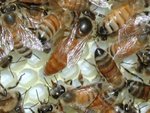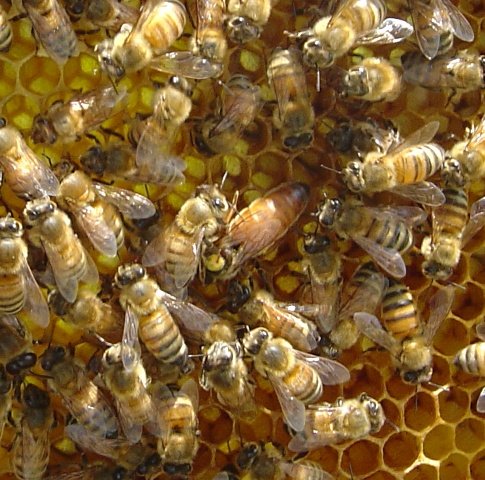 .
.Left: Hive open on a 45 degree February Day. You can see that much of the candy feed has been consumed by the bees over the last month.
.
.
.
.
.
.
Will my bees survive the winter cold? Has it been cold for too long? Are the bees starving in place because it has not been warm enough for them to relocate to fresh stores of honey?
 .
.Right: Another open colony. Not as much candy feed has been consumed.
.
.
.
.
.
.
.
.
After weeks of cold, the temperature finally pushed its way above 40 degrees, the bees broke cluster and commenced their cleansing flights. This gave me the opportunity to peak in under the cover to see how the bees were doing and whether or not candy needed to be added to help them survive the winter.

.
Left: Bees take to the air for a cleansing flight. Winter bees do not get out much!
.
.
.
.
.
.
.
.
.
Upon opening the hives it became apparent that the bees had consumed about half the candy I had placed in the hives in January. I was please to see that all of the hives were doing well. Most had 5 frames of bees, not bad for February. The queen should start laying eggs sometime within the next few weeks to start replenishing the workers lost over the winter.

.
Right: Close up of bees feeding on sugar candy. This candy supplements their stores of honey to help stretch their food for the long winter.
.
.
.
.
.
.
With this inspection I am hopeful that all the hives will survive this winter. Of course it is not the end of March yet. March is the month where the greatest bee loses occur. If their number s dwindle to low, the bees will not be able to keep themselves warm enough to survive. Many colonies die only a few weeks away from the bloom of first spring flowers.

.
Left: A bee and a hive beetle on a removed sticky board. The dead hive beetle was not there on the last inspection in January. Evidence that there are small hive beetles surviving the winter within the cluster of bees.
.
.
.
.
.
.
The bees in the hive now, are the bees which emerged last September, five months ago! They have not seen much other than the inside of the colony. They have spent much of their life keeping the colony warm, feeding on the stores of honey and pollen left there by their many sisters the summer before they were born.

.
Right: A worker bee rests on the edge of a brick, warming itself in the sun before flying back to the colony
.
.
.
.
.
.
.
.
Now begins the buildup of the colony in preparation for the honey flow in June and July. Starting in March we will begin feeding the colonies pollen, and sugar syrup to further stimulate their increase in numbers. We want the colonies strong in numbers for the honey flow. The more bees collecting pollen and nectar, the more honey will be produced.
March will tell…. March will tell…







No comments:
Post a Comment